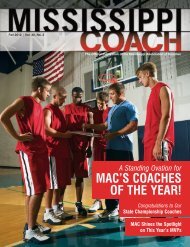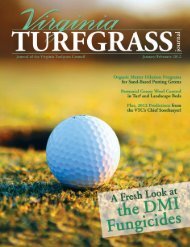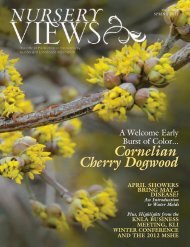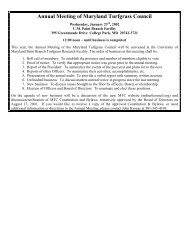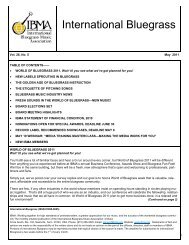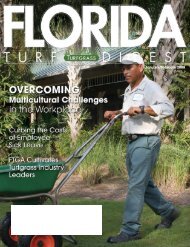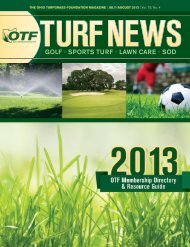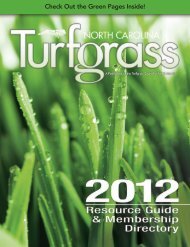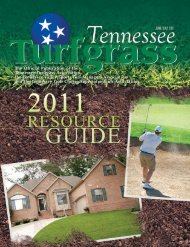ULTRADWARF BERMUDAGRASS
ULTRADWARF BERMUDAGRASS
ULTRADWARF BERMUDAGRASS
- No tags were found...
Create successful ePaper yourself
Turn your PDF publications into a flip-book with our unique Google optimized e-Paper software.
March/April 2011VOL. 28/NO. 2<strong>ULTRADWARF</strong><strong>BERMUDAGRASS</strong>Putting Green FertilityManagementHEALTH, ROOTS,SPEED AND… SLEEPDROUGHT RESPONSEOF TURFGRASSES:Assessment Using a LinearGradient Irrigation SystemBLOGGINGfor Outreach, Public Relationsand Self-Promotion
Official Journal of the Florida Turfgrass Associationtable of contentsMarch/April 2011VOL. 28/NO. 2Cover StoryFocus on IrrigationFeature StoryUltradwarf BermudagrassPutting GreenFertility Management12Drought Responseof Turfgrasses22Health, Roots, Speedand… Sleep32More FeaturesTechnologyBlogging for Outreach, Public Relations and Promotion .................................. 40DepartmentsEditor’s Corner ............................................................................................................ 6President’s Message ...................................................................................................... 8News from the FTGA .................................................................................................... 9From the Executive Director ...................................................................................... 10Welcome New Members ............................................................................................ 11Membership Application ............................................................................................ 48Index of Advertisers .................................................................................................. 50EDITOR-IN-CHIEF Darren J. DavisPUBLISHER Leading Edge CommunicationsMANAGING EDITOR MJ PlasterTECHNICAL ADVISOR J. Bryan Unruh, Ph.D.www.ftga.orgCover photo courtesy of Darren J. Davis.The Florida Turfgrass Association (FTGA)serves its members in the industry througheducation, promotion and representation.The statements and opinions expressedherein are those of the individual authors anddo not necessarily represent the viewsof the association, its staff, or its board ofdirectors, Florida Turf Digest, or its editors.Likewise, the appearance of advertisers, orFTGA members, does not constitute anendorsement of the products or servicesfeatured in this, past or subsequent issues ofthis bimonthly publication. Copyright ©2011by the FTGA. Florida Turf Digest, is publishedbimonthly. Subscriptions are complimentaryto FTGA members. POSTMASTER: Sendchange of address notification to FTGA, 120East Pine Street, Suite 1, Lakeland, FL 33801.Postage guaranteed. Presorted standardpostage is paid at Nashville, TN. Printed in theU.S.A. Reprints and Submissions: Florida TurfDigest, allows reprinting of material publishedhere. Permission requests should be directed tothe FTGA. We are not responsible for unsolicitedfreelance manuscripts and photographs.Contact the managing editor for contributioninformation. Advertising: For display andclassified advertising rates and insertions, pleasecontact Leading Edge Communications, LLC,206 Bridge Street, Franklin, TN 37064,(615) 790-3718, Fax (615) 794-4524.4 florida turf digest • march/april 2011
Editor’s Corner“Chose a job you love, and you will never have to work a day in your life.”— ConfuciusBy Darren J. Davis,Editor-in-ChiefTheancient Chinese philosopherwas spot on, and I do have ajob I love—so much so thatit’s hard to believe that it hasbeen almost 25 years since I first strapped on myboots and became a member of the local golf coursegrounds crew. I feel fortunate to have remained inthis terrific industry, and even today the tremendousfeeling of excitement that rushed through my bodythat first day on the job is amazingly lucid.Truthfully, feeling the love and having a passion forthe profession is almost a prerequisite in this industry,because at times, being a golf course superintendentcan be taxing. However, the trials and tribulations areeasy to forget when you smell the fresh cut grass,listen to the sound of birds chirping as the sun rises,see the excitement on a golfer’s face after sinkinga long putt, and especially after a long day whenyou watch the shadows grow as the sun sets acrossthe course.It is obvious that I thoroughly enjoy being a golfcourse superintendent. Consequently, I do not wantto change careers, which unfortunately is becominga reality for some of my peers. Golf courses need golfersto stay profitable and keep staff employed, butover the last decade, golf has been in a recession andis in need of resurgence. The total number of peoplewho play has declined or remained flat each yearsince 2000. Equally troubling is the reduction ofrounds being played by avid golfers. The departureof golfers is part of a broader decline in outdoor activitiesincluding tennis, swimming and biking. Theproblem is also one of time and the change in thetraditional family model. Years ago, men had verylittle concern over spending the whole day, maybetwo days a week, playing golf. Today’s father drivesthe kids to soccer practice, and if he plays a roundon Saturday morning, he is often home by noon. Thedownturn in golf is also economic in nature. Workingmore than one job is not uncommon today; wagesare not going up and pensions are going away. Thedecline in golf is producing economic challenges atsome facilities and creating the need to analyze allexpenses—including potentially reducing staff.So what can a golf course superintendent do tohelp solve this dilemma? Once referred to as greenkeepers,today’s golf course superintendent musthave a thorough understanding of the complexitiesand interrelationships of soils, irrigation, plant pathology,entomology, plant fertility, drainage and keep upto date with the ever-increasing technical advancementsin turfgrass science. Superintendents must beable to secure, train, supervise and communicateeffectively with employees. In general, a superintendent’sprimary responsibility is to ensure that the golferis provided the finest playing conditions possible. Inaddition to these traditional responsibilities, today’sgolf course superintendent is also a business manager,and in today’s marketplace must assist others at theirfacility in growing the game and showcasing golf’snumerous positive attributes.Despite the fact that nationwide there are morethan 10,000 public golf courses with two million jobsconnected to the industry, and that golf courses areundeniably a land use that’s compatible with the environment,golf has not been able to completely shakeits elitist image. That longstanding perception of thegame does not square with the facts; golf does havea good story to tell! The fact is that golf is more thanjust a game; it is a major industry that creates taxrevenues, spawns tourism, generates millions of dollarsfor charity and provides numerous environmentaland social benefits. In Florida alone, there are over1,100 golf courses with a direct golf economy of 7.5billion dollars providing a total wage income of 4.68billion dollars to over 165,000 individuals. Thesefacts and positive golf statistics can be found athttp://wearegolf.org/.WE ARE GOLF is a new coalition led by the GolfCourse Superintendents Association of America, theClub Managers Association of America, the NationalGolf Course Owners Association and the PGA ofAmerica. Together the associations are collaboratingto tell the true story of golf—not just the game, butalso the stories of the hardworking folks who make itthe greatest sport in the world and whose livelihoodsdepend on it. These accounts affirm that the continuedhealth and growth of the golf industry is vital tothousands of communities across the country andinstrumental in enhancing the lives of millions ofAmericans. If you are a golf course superintendentor are connected to the industry, I urge you to familiarizeyourself with WE ARE GOLF and join thecause. Furthermore, I hope that you will communicatewith your team members and colleagues in theindustry and do whatever you can do to introduceothers to golf and to help grow the game!The Florida Turfgrass Association provides strongleadership as an umbrella organization to ALL Floridaturfgrass professionals, and WE ARE (in part)GOLF. Consequently, as you flip through this issueof the Digest, you’ll notice that a large percentageof the issue focuses on golf. We hope that you enjoythis as well as every other non-golf issue! ❂6 florida turf digest • march/april 2011
President’s MessageBy Mac Carraway,FTGA PresidentTRADE SHOWS MUSINGSBeginning in the fall, and specifically withthe 2010 FTGA Conference & Show, therehas been a packed calendar of trade showsavailable to many of us. For our company,we do shows related to turf and trees, from Floridato Alabama to Texas to South Carolina, which seemslike a lot—and it is. But when I started to think aboutit, the potential for doing trade shows for certainvendors in our industry (e.g. crop protection chemicalsand machinery in particular), the number ofpotential shows is even greater. For any of us whoparticipate as an exhibitor, each one of those opportunitiesrequires a separate business decision regardingthe actual investment of people, travel, logistics,meals, lodging, booth materials, literature, marketing,communications, out-of-office time, etc. As anattendee, you need to do a similar evaluation regardingmany of those same costs and what that investmententitles you to or gives you access to. There areplenty of folks who regularly commit to these showsas either exhibitors or attendees, but it’s worthasking the question, “Has anything changed abouttrade shows?”For the last couple of years, the obvious answer tothat question is that the shows are smaller from anexhibitor standpoint. At the depths of the recession,certain exhibitors and many attendees found plentyof reasons to stay away. But with recent economicnews starting to be more encouraging, the just-completedGolf Industry Show in Orlando was a goodchance to get a feel for where the larger-scale showsare heading. Having attended GIS as an exhibitor, abuyer and an FTGA member, there were some observationsI took home with me (these are my opinionsonly, of course):• While smaller in physical footprint, the “criticalmass” of vendors (i.e. the mix of products, qualityand depth) at GIS and other recent shows has beenexcellent. It provided attendees with the opportunityto look at various vendors and to make it acrossthe show in two days or less without feeling likeyou had walked the Appalachian Trail.• Attendees there seemed very focused and eager toobtain the latest information from exhibitors. Thisis kind of an intangible, but you definitely know itwhen you experience it. While “head count” is animportant stat for these shows, the quality of eachof those visits is a WAY more important stat, to meanyway, and the quality of visits this year was betterthan in quite some time. I base that on talking toother exhibitors as well, not just what happened atour booth. I attribute that to the fact that the populationof attendees at recent shows has been moreconcentrated with those who really needed to findsomething to help their businesses. This correlatesto the current economic situation in which thosewho are surviving and thriving are finding ways todifferentiate themselves from their competition—through technology, service, costs or all of theabove. Trade shows offer a truly excellent opportunityfor both vendors and attendees to address thatvalue proposition. And while clearly important tothe overall marketing process, no amount of admarketing or social networking can replace talkingface to face with either your prospective vendoror your prospective customer. Some parts of “oldschool” will never get old.• Almost as important as the show are the opportunitiesto network that surround the shows. In thesesettings, some sponsored and with limited accessand some with open access, the relationship buildingis often at its highest and best. Normally, folksare generally more relaxed in the after hours, andit is wise to make use of this extra face time to makethe most of your trade show experience. Plus, younever know what kinds of unexpected connectionsyou might (and probably will) make with just a littlebit of effort and friendliness—it never ceases totruly amaze me.With that said, there is one other aspect of tradeshows that needs to be mentioned on a somewhat lessstrategic note. For example, see if you can properlyanswer this question:Question:Answer:What is the difference between tradeshow convention center food and abowling ball?You could eat a bowling ball if youhad to.While I have to admit the food offerings at someof these venues are better than they used to be, thatis a very relative statement, and they are still far frombeing something that you might actually look forwardto. Instead, it comes down to which of the marginallyappetizing options you are going to forceyourself to partake of that day. Well at least it’s affordable.No wait … it actually costs a small fortune also,kind of like the concession stand at the movies butwithout any of the fun.But in the end, trade shows and exhibitions arevery much alive and well. I believe this bodes wellfor the 2011 FTGA Conference & Show, and I’ll lookforward to seeing you there. ❂P.S. The food will be pretty good too.8 florida turf digest • march/april 2011
NEWS FROMTHEFTGAFlorida Turf Digest is theofficial publication of theFlorida Turfgrass Association120 East Pine StreetSuite 1Lakeland, FL 33801(800) 882-6721 or(863) 688-9413Fax: (863) 688-9610info@ftga.orgwww.ftga.orgAsmentioned in the last issueof Florida Turf Digest, theMembership Services Committee,under the leadershipof Mac Briley, with the approval ofthe board, has introduced a new membershipstructure with expanded membershipoptions.The Individual Membership Applicationcan be found on page 48 of this issue.To view a list of current member benefitsor to download a copy of the Individualor the Group (Corporate) MembershipApplication, visit https://www.ftga.org/member-benefits. ❂Published byLeading Edge Communications206 Bridge StreetFranklin, TN 37064(615) 790-3718Fax: (615) 794-4524info@leadingedgecommunications.comFTGA Executive DirectorPete Snyderpete@ftga.orgFTGA Marketing & Events CoordinatorHeather Russoheather@ftga.orgFTGA EXECUTIVE COMMITTEEPresidentMac CarrawaySMR Farms, LLC(941) 708-3322mac.carraway@smrfarms.comVice PresidentArmando Campos, CCA, CTPNutrient Technologies, LLC(407) 610-7563acampos2009@cfl.rr.comSecretary/TreasurerMac BrileyCity of Ocoee(407) 905-3100abriley@ci.ocoee.fl.usImmediate Past PresidentGregory A. PhenegerJohn’s Island Club(772) 231-1700gregp@johnsislandclub.orgflorida turfgrass association • www.ftga.org9
From the Executive DirectorHOLLYWOOD...By Pete Snyder,FTGA ExecutiveDirectorIthas all the makings of a Hollywood epic.Agitators stir up a community with misleadingstatements that are based on halftruths,innuendo and falsehoods. Yet theyclaim their cause is just, and it will rid the communityof the danger that is plaguing them.The agitators position themselves as protectors ofthe communities—posing as “environmentalists” whowill take on evil industrial interests to protect localresidents from poisonous waters, air and foodstuffs.Their pitch is highly emotional; yet very simple—ban it—ban what they say is so evil.If asked why they feel their pitch is right, theyanswer rhetorically—they know what is right, theyare the protectors of communities. Scientific evidencethat refutes their claim is discounted; thescience can’t be trusted.And the fear-mongering continues.Unfortunately, this potential Hollywood scenariois all too real. It is being played out in local communitiesand county commissions across the state ofFlorida. And it is coming to a community near you.Environmental extremists are advocating a fourmonthsummertime ban of all fertilizer applicationson turfgrass. They cite the like-minded TampaBay Estuary Program’s “model” (which lacks peerreviewedsubstantiation) as proof that they are right.When IFAS suggested that such a policy was notprudent and, in fact, would have “unintended consequences”for the environment, extremists triedto sully the science by saying that it was paid for bythe turfgrass industry. Extremists went so far as toquestion the veracity of several IFAS scientists.Editorial pages of newspapers repeated the allegations,yet never asked the turfgrass industry howmuch was paid (a small fraction of the overallresearch need) nor what was paid for (not onestudy was on fertilizer use).Yet the extremists’ juggernaut continues. To combatthe attacks, a loose coalition of green industryrepresentatives is working to keep science in the forefrontof community decisions. As of late February,the most pressing situations are:The City of Stuart will likely hold a second readingand vote on their proposed ordinance soon. Thefirst reading was on February 14th, and the draftlargely mirrors the State Model Ordinance, whichthe turfgrass industry can support.St. Lucie County has a public hearing coming up,and they are expected to vote on an ordinance thatnight. The county’s environmental protection staffis recommending a modified version of the StateModel Ordinance, which we can support. However,there is an alternative version being pushed by an adhoc “environmental advisory committee” that hasthe usual unscientific restrictions such as summertimeblackouts and 50 percent slow releasefertilizer requirements.Manatee County has postponed a fertilizer ordinanceworkshop pending the outcome of work beingdone by the Florida Legislature on the issue. Thecounty’s staff has recommended an ordinance thatmirrors the Tampa Bay Estuary Model Ordinance—with summertime blackouts on use and sales.Manatee County has an interlocking agreementwith the Tampa Bay Estuary Program, and they areusing this model as the starting point. However, theManatee County Commission will also look atother surrounding ordinances, such as those inHillsborough County, which has opted to followthe state model, so there may be some hope inManatee County.Collier County has conducted a series of workshopswith different groups of interested parties, andthey are going to release a draft ordinance in thenear future. It is suspected that it will contain blackoutperiods and 50 percent slow release requirements,as many groups (such as the SW FloridaNature Conservancy, Sierra Club and the SW FloridaRegional Planning Council) have been pushing forthese restrictions. No timetable has been set yet onadditional actions by Collier County.Consultant Todd Josko of Josko & Associates didsome crystal ball gazing and suggested that the industryshould keep a lookout for activity in Polk, Citrusand Martin Counties; perhaps in Palm Beach andBrevard Counties as well. Please remain vigilantand report any activity to FTGA.On February 21, IFAS released the newest versionof “Unintended Consequences.” The document(http://edis.ifas.ufl.edu/ss496) makes a strong caseagainst summertime bans of fertilizer applications.It cites over 140 scientific attributions and separatereferences from academic and governmental institutionsacross the United States. It presents a tremendousbody of science.Armed with this information, turfgrass industryrepresentatives can be conversant in the debate, whichis encouraged. Please contact me at Pete@FTGA.orgif you are willing to get involved. Thank you. ❂10 florida turf digest • march/april 2011
Cover Story12 florida turf digest • march/april 2011
By John H. Foy, Director, Florida Region, USGA Green SectionThelate 1990s’ introductionof theultradwarf bermudagrasscultivarsChampion, Mini-Verde and TifEaglewas a milestone for golf courses in Floridaand the Southeast. Compared to thelongtime standard Tifdwarf bermudagrass,the ultradwarfs have a highershoot density, a finer leaf blade and areable to tolerate the continual practiceof lower heights of cut. These characteristics,combined with improvementsin equipment technology, raised the barwith respect to the level of conditioningand quality that can routinely be providedwith bermudagrass putting greens.Even though the ultradwarfs are bermudagrasses,some time has been neededto fine-tune management programs formaintaining both healthy turf growthand top quality putting green conditioningin keeping with golfer desiresand expectations.Since the ultradwarfs arrived inFlorida, Senior Agronomist Todd Loweand I have annually conducted hundredsof USGA Green Section TurfgrassAdvisory Service (TAS) visits to golfcourses throughout the state whereultradwarf bermudagrass puttinggreens are being maintained. Duringour site visits, all aspects of puttinggreen management are reviewed anddiscussed; and this provides us with anexcellent base of information withregard to the practices that havebeen consistently producing the bestresults. This article takes a look at oneof the most basic and integral practices—fertilization.Essential nutrientrequirementsBefore discussing specific aspects ofultradwarf bermudagrass fertilization, aquick review of some basic considerationswill be provided. All green plantsrequire 17 nutrients for photosynthesis,production of carbohydrates, and thehundreds of complex organic compoundsinvolved in the normal growthprocess. Carbon, hydrogen and oxygenare essential nutrients required in thegreatest quantities and are basic inputsin photosynthesis. Atmospheric carbondioxide enters the plant through leafstomata and supplies carbon andoxygen. Water molecules taken up bythe root system are subsequently split,and this supplies both hydrogen andoxygen for plant growth processes.Drought stress, which results in partialor full stomatal closure, can limit carbondioxide uptake. However, even whenturf is in a drought-stressed condition,there is usually sufficient soil moisturepresent to support photosynthesis.Thus, supplying the essential nutrientsof carbon, hydrogen and oxygenis really not a consideration in turfgrassfertilization.florida turfgrass association • www.ftga.org13
Cover StoryAs far as the 14 other essential elements,nitrogen, phosphorous, potassium,sulfur, magnesium and calciumare classified as macronutrients, becausethese elements are found in plant tissueabove 1,000 ppm. Iron, manganese, zinc,copper, molybdenum, boron, chlorineand nickel are essential micronutrients,and these elements are typically foundin plant tissue below 100 ppm. Sufficientlevels of macro and micronutrients mustbe available for sustained healthy turfgrowth, and naturally these are thenutrients that need to be consideredin development of a proper fertilizationprogram.SLAN versus BCSRMaintaining healthy turf and consistenttop-quality putting green conditioningis both an art and a science. On thescience side, soil and turfgrass nutritionresearch provides basic guidelines onthe quantities of essential nutrients thatmust be available to support growth.Especially today, given environmentaland economic concerns, it is essentialthat fertilization programs be based onbest management practices (BMPs), andthis includes the use of soil test information.Soil testing is the best and mostcommon method for determining nutrientavailability and, in turn, makingsound decisions on how much and whatfertilizer materials need to be applied.Tissue testing is another useful tool;however, additional research is neededto correlate nutrient levels in the tissuewith turfgrass responses. Therefore atthis time, tissue testing is best utilizedas a diagnostic procedure.As far as the interpretation of soil testresults and, in turn, fertilization needs,sufficient levels of available nutrients(SLAN) and basic cation saturationratios (BCSR) are the two methods mostcommonly used. For a detailed reviewof these two methods of soil test interpretation,a list of reference articles hasbeen included at the end of this article.With the SLAN approach, sufficiencylevels for phosphorous, potassium, calcium,magnesium, sulfur and the micronutrientshave been determined for allof the commonly used turfgrasses. Whensoil test levels are below the sufficiencylevel, a response to an application of anutrient is likely to occur. With theBCSR method, the percent saturationof basic cations (K, Mg, and Ca) is usedas a guide to determine whether theyare in balance. Ratios of cation saturationpercentages are also considered.The BCSR approach contends that thereare ideal ratios for optimum plantgrowth and that with “feeding the soil”and maintaining appropriate amountsof basic cations, optimum soil structureand microbial activity is also achieved.This is not a crop specific approach, andsubsequent research does not supportthe theory that there are ideal cationrations for optimum chemical, physicaland biological soil properties.There are other concerns with exclusiveuse of the BCSR approach. Thisapproach can lead to unnecessary applicationsof calcium and ignores the quantityof potassium and other nutrients inthe soil. Thus even if the base cationsare present in the correct proportions,a nutrient deficiency can still occur.Inadequate levels of cations/nutrientsare most likely to occur with highsand content rootzones that have a lowcation exchange capacity (CEC). In ascenario where high sodium contentwater is being used for irrigation, theBCSR method does have a place in themanagement of sodium and solublesalt accumulation.Having spent a great deal of timestudying the subject of soil test interpretation,focusing on the amount ofnutrients that are present and, in turn,use of the SLAN approach makes themost sense when it comes to fertilitymanagement with ultradwarf bermudagrassesin Florida. Again, high sandcontent putting green rootzone mixeshave very low nutrient retention, and thissituation is only further compoundedby leaching when you add in 40 to 60inches of annual rainfall. Unless elevated14 florida turf digest • march/april 2011
Cover StoryThe typically low cation exchange capacity (CEC) of high sand content putting green rootzonemixes does add to the challenge of maintaining adequate nutrients to support sustained andbalance growth with the ultradwarfs.sodium levels are present in the irrigationwater, keep things simple and worryabout the basics of pH, phosphorous,potassium and magnesium.Feed the turf,but not too muchIt has been interesting to follow the finetuningof ultradwarf bermudagrass puttinggreen fertilization. As the case withboth TifGreen (328) and Tifdwarf, generalfertilization recommendations forboth establishment and maintenance ofthe ultradwarfs have been provided bythe developer/breeders of the cultivars.Yet, every golf course and every set ofputting greens are unique, and the artof greenkeeping becomes an importantfactor in producing top-quality playingsurfaces.With Tifgreen and Tifdwarf, it wasrecommended to apply nitrogen, phosphorousand potassium in a 3-1-2 ratioand supply 1.5 to 2.5 lbs. of nitrogen per1000 sq. ft. per month during the growingseason. These recommendationswere geared for maintaining a dense andlush green turf cover. The ultradwarfsinherently have a much higher shootdensity, and thus far less nitrogen isneeded for maintaining a dense and fullturf cover. It was also recognized earlyon that the ultradwarfs produce thatchat a faster rate compared to the oldercultivars, and thus the use of reducednitrogen can aid in minimizing thisproblem. The application of 0.5 to 1.0lbs. of actual nitrogen per 1000 sq. ft.per growing month has been the generalfertilization recommendation with theultradwarfs. During TAS visits to coursesthroughout the state, however, it hasbeen found that there is still a fairlywide range of between 6 to 18 lbs. ofnitrogen per 1000 sq. ft. being appliedannually. At the courses with which wework, where a good balance betweenturf health and surface conditioning isachieved, total annual nitrogen fertilizationrates in the range of 8 to 12 lbs.per 1000 sq. ft. are being utilized.As far as phosphorous fertilization,and especially because of current dayconcerns over potential negative environmentalimpacts, its applicationshould be based strictly on soil test recommendations.With mature, establishedbermudagrass putting greens in Florida,adequate to high soil test levels of phosphorusare typically reported. On theother side of the coin, however, low tovery low soil test levels for potassium arecommonly encountered with Florida’ssandy soils. Maintaining soil potassiumin the sufficient range is extremelyimportant because of its role in variousphysiological processes and maximizingthe turf’s tolerance to drought, cold,heat, wear and salinity stresses. Especiallyin high stress situations, the applicationof potassium in a 1:1 ratio with nitrogenhas been a longtime recommendation.However, application rates as high as35 lbs. of potassium per 1000 sq. ft.annually were being utilized on ultradwarfputting greens at some coursesbecause of the perceived benefits toturf health and quality. While concernsabout negative environmental impactsfrom excessive potassium applicationhave not been raised, this can result inincreased salinity problems. However,with skyrocketing material costs overthe past two or three years, economicshas dictated a reduction in potassiumapplication rates.Magnesium is also very mobile insandy soils and thus low to very lowlevels are common with ultradwarf16 florida turf digest • march/april 2011
Cover Storybermudagrass putting greens. While notrequired in similar quantities relative tonitrogen and potassium, maintainingmagnesium in the sufficient range is veryimportant because of its direct influenceon turfgrass growth. It would also bereiterated that the quantity of magnesiumand calcium in the soil is the primaryfactor that influences turf growth,and research has shown that there is noideal calcium to magnesium ratio.Spoon feeding of ultradwarf bermudagrass putting greens is the standard approach and at mostcourses a combination of liquid and granular fertilizer formulations are being used.Trends in fertilizationRegular and proper soil testing, alongwith interpretation of results, are basiccomponents in development of a successful,economical and environmentallysound ultradwarf fertilization managementprogram. However, unique andmultiple factors must be taken into considerationin each situation, plus the18 florida turf digest • march/april 2011
weather variable; thus it is simply notpossible to provide a cookbook recipeof an application of XYZ product onpredetermined calendar dates. This isespecially true when it comes to nitrogenfertilization of the ultradwarfs.Based on experiences in the field, thebest results are being achieved with judiciousspoon feeding to maintain a denseturf cover and to support sustained, butnot excessive growth. A common denominatoramong the top managers withwhom we work is that they closely monitorthe density and growth rate (clippingyield) of their ultradwarf putting greensand employ a spoon feeding nitrogenstrategy. It is understood that, unlikeother types of agriculture, maximizingproduction or crop yield is not the mostimportant consideration in maintainingoptimum playing conditions for thegame of golf. Furthermore, there isreduced reliance on nitrogen for maintaininglush green ultradwarf puttinggreens. The micronutrients iron andmanganese are being used to a muchgreater degree to compensate for lowernitrogen fertilization and, in turn, maintainan acceptable color character.Prior to the introduction of the ultradwarfcultivars, applications of granularcomplete-type fertilizer formulationsplus fertigation was the most commonstrategy for supplying the essential nutrientsto putting greens. However, evenwith “greens grade” granular formulations,the particles would remain on thesurface for a long time following anapplication on dense and close cut ultradwarfputting greens. Being able touniformly apply lower rates of fertilizerswas another logistical challenge, andthus there was a fairly rapid shift to makingspray applications of soluble nutrientsources. Liquid spoon feeding is alsowell suited for managing putting greenswith a shallow root system and beingable to more precisely control growth.The fertilizer manufacturers haveresponded to this change in applicationstrategies, and now there is a wide arrayof formulations for use in spray applicationprograms on ultradwarf puttinggreens. Furthermore, the concept offoliar feeding has been popularized overflorida turfgrass association • www.ftga.org19
Cover Storythe past few years. Research has proventhat foliar uptake of nutrients doesoccur, primarily through trans-cuticularleaf blade pores. However, it does needto be remembered that in terms ofefficiency, root uptake of nutrients isgreater and generally works betterthan shoot uptake.Light and frequent applications ofnitrogen are the best strategy with theultradwarfs. Yet with exclusive liquidspoon feeding, it can be difficult tomaintain sufficient availability of othernutrients, and in particular potassium.Furthermore, granular formulations arethe best approach for combating largenutrient deficiencies. Again, at themajority of golf courses that we visit,both liquid and granular fertilizer applicationsare being utilized in the managementof ultradwarf putting greens.In conclusionThere is no argument that turfgrassnutrition and soil fertility can be complexand intimidating subjects. Yet bypaying attention to a few basic principles,an agronomically sound, effectiveand economical ultradwarf fertilitymanagement program can be realized.ReferencesTextbook: Turfgrass Soil Fertility andChemical Problems — Assessment andManagement by Carrow, Waddington,and Rieke, 2001.Carrow, R. N., L. Stowell, W. Gelernter,S. Davis, R.R. Duncan, and J. Skorulski.2004. Clarifying Soil Testing III. SLANSufficiency Ranges and Recommendations.Golf Course Management. 72(1):194-197. http://www.gcsaa.org/gcm/2004/jan04/PDFs/01Clarify3.pdf.Baird, James. Soil Fertility and TurfgrassNutrition 101. http://www.usga.org/Content.aspx?id=26211Whitlark, Brian. 2009. Overcomeyour Infatuation with Base Saturation.http://www.usga.org/turf/green_section_record/2009/may_jun/base_saturation.pdf. ❂20 florida turf digest • march/april 2011
Focus on IrrigationBy J. Bryan Unruh, Associate Professor, University of FloridaHear Ye, Hear Ye: Read allAbout It! “The Devil Grass:Water-hungry St. AugustinegrassSucking up FreshWater” 1 and “Thirsty Grass Has EvilRoots” 2 are headlines from prominentnewspapers in Florida. These inflammatoryheadlines, often void of sound science,are puzzling and they leave greenindustry professionals and gardeningenthusiasts confused about which turfgrassperforms the best in Florida’sdiverse climatic conditions.All agree that Florida’s population isexpected to steadily increase in the yearsahead. Maps showing current (Fig. 1)and projected development (Fig. 2) inFlorida are alarming. As developmentcontinues and the population swells,huge constraints on Florida’s naturalresources—especially potable water—areinevitable. As the battle rages over wateruse, elected officials and regulators arecaught in the unenviable position oftrying to balance supply and demand.In recent years, we have seen examplesof what is to come. Ordinances22 florida turf digest • march/april 2011
NO SCALEDeveloped LandConservation LandsPermanently ProtectedAbove: Fig. 1. Florida Today. Available at http://www.1000friendsofflorida.org/PUBS/2060/2060-executive-summary-Final.pdf.Below: Fig. 2. Florida in the year 2060. Available at http://www.1000friendsofflorida.org/PUBS/2060/2060-executive-summary-Final.pdf.Above: Fig. 3. Initial stage of constructioninvolved removing 12" of topsoil and stockpilingit.placing square footage restrictions onturfgrass have been imposed by countygovernments and local municipalitiesin an effort to restrict the demand forNO SCALEDeveloped LandConservation LandsPermanently Protectedflorida turfgrass association • www.ftga.org23
Focus on IrrigationFig. 4. The subgrade was laser-leveled andshaped to provide a 5" drop from the outsideinward to ensure all surface water flows tothe center as evidenced during the rain event.water (i.e., fewer plants = less outdoorwater use). Similarly, Water ManagementDistricts have imposed wateruse restrictions (e.g., one, two or threedays per week; limited hours for irrigation)in an attempt to curtail outdoorwater usage.These restrictive efforts have beenmet with fierce opposition by those inthe green industry, because these restrictionscan severely cripple the financialviability of green industry businesses.Green industry suppliers and servicebusinesses correctly argue that plantsdo not waste water—people do. Assuch, an informed citizenry—obtainedthrough proper education and outreach—isthe best defense to curbwasteful water use practices.Proper education isbetter than regulationGood education requires a clear understandingof the issues at hand. Oneaspect of this complex turf/water/drought issue that lacks clarity and hasgreat confusion is the terminology usedto define a plant’s ability to handledrought conditions. For the purpose ofclarity, Drought Resistance is the abilityof a plant to survive prolonged droughtstress through Drought Tolerance andDrought Avoidance mechanisms.Drought Tolerance occurs whenplants either “escape” the droughtthrough life cycle modifications such asentering dormancy sooner or producingseed for regeneration purposes.24 florida turf digest • march/april 2011
Plants may also tolerate the droughtthrough cellular level adjustments makingthem hardier.Drought Avoidance occurs when plantfactors are modified. For example, certainturfgrass species grow deeper rootsor have enhanced root viability. Both ofthese factors influence soil water uptake.Turfgrasses with deeper roots can minethe water from greater soil depths. Additionally,certain plants have the abilityto limit or reduce evapotranspiration(ET), allowing them to avoid droughtContinued on page 28 >florida turfgrass association • www.ftga.org25
Focus on Irrigationstress. Factors such as shoot density,number of leaves per unit area and leaforientation all affect ET rates. Similarly,leaf width and leaf extension rate contributeto the total leaf area. A largerleaf area equates to a larger evaporativesurface and generally equates to greaterwater usage. When a plant is able tomaintain adequate tissue water content,it can avoid or postpone the stress.Some of the UF Turf Team membersthink that a better phrase to use whentalking about the influence of droughton turfgrass is Drought Response.Grasses undergo many changes inresponse to drought and some of theseresponses are not easily noticed. However,they have a profound effect on theplant’s ability to withstand drought.Some of these changes can be verydifficult to quantify in the laboratory.Other changes are readily observed andeasily quantified. With this in mind, andthe fact that limited field research inFlorida has documented which turfgrassactually performs best under droughtconditions, we initiated a project to gaina better understanding of the droughtresponse of the major turfgrass speciesand cultivars grown in Florida.Construction of a droughtresearch facilityIn April 2007, we began constructionof a three-acre Linear Gradient IrrigationSystem (LGIS) at the University ofFlorida, West Florida Research and EducationCenter (WFREC) near Pensacola,Fla. The system was modeled after asystem designed and installed at TexasA&M University by Dr. Milt Engelke.At the onset of construction, 12" oftopsoil was removed and stockpiledusing heavy equipment (Fig. 3). Thesubgrade was shaped and laser-leveledto provide a 5" drop from the outsideedges inward to ensure that all surfacewater flows to the center (Fig. 4).After the subgrade was established,the topsoil was replaced and the finalgrade was established using laserguidedimplements.The LGIS has a triple row irrigationsystem with the central line having anirrigation head spacing equal to 33percent of the throw of the irrigationFig. 5. Twenty-eight turf cultivars were plantedon 10’ X 80’ plots perpendicular to the lineof the irrigation heads.28 florida turf digest • march/april 2011
heads. This spacing allows for considerableoverlapping from head to head andensures uniform distribution of waterperpendicular to the irrigation line. Theoutside rows of irrigation heads aretriangulated to the central head of thecenter trench and were used only duringthe establishment period to ensureuniform plot establishment and whenfertilizer treatments need to be wateredin. In September 2008, 27 commerciallyavailable turf cultivars (Table 1) wereplanted on 10’ X 80’ plots running perpendicularto the center irrigation line(Fig. 5). This allows for the comparativeperformance of each of the grassesunder very high water application (centerof the LGIS) to the outer edge whichreceives no supplemental irrigation. Allflorida turfgrass association • www.ftga.org29
Focus on IrrigationFig. 6. Turfgrass breeding lines (Africanbermudagrass, zoysiagrass, carpetgrass,and centipedegrass) from Dr. KevinKenworthy’s program were plugged on 18"centers on the LGIS.Fig. 7. A dry period in June 2009 allowedfor some initial data collection from theturfgrass cultivars planted on the LGIS.30 florida turf digest • march/april 2011
of the sod and shipping costs weredonated by sod producers from Florida,Alabama, Georgia, South Carolina andTexas. An additional 30 turfgrass breedinglines (African bermudagrass, zoysiagrass,carpetgrass and centipedegrass)from Dr. Kevin Kenworthy’s programwere plugged on 18" centers (Fig. 6) andthe University of Georgia experimentalline, DT-1, was added to the LGIS inearly 2010.Since 2009, periodic drought conditionshave allowed us to capture somefield data (Fig. 7). Because of seasonaland annual variations in climatic conditions,conclusive results from thisresearch will not be available for severalyears. For more information onthis project or others conducted by Dr.J. Bryan Unruh, please contact himat jbu@ufl.edu. ❂1 http://staugustine.com/stories/112507/news_017.shtml2 http://www.seminolechronicle.com/vnews/display.v/ART/4797cfd2a03a5Table 1. Turfgrass cultivars currentlyinstalled in the Linear Gradient IrrigationSystem at the University of Florida, WestFlorida Research and Education Center.1 Floratam St. Augustinegrass2 Classic St. Augustinegrass3 Palmetto St. Augustinegrass4 Raleigh St. Augustinegrass5 Sapphire St. Augustinegrass6 Captiva St. Augustinegrass7 Empire Zoysiagrass8 Ultimate Zoysiagrass9 JaMur Zoysiagrass10 El Toro Zoysiagrass11 Cavalier Zoysiagrass12 Palisades Zoysiagrass13 Zorro Zoysiagrass14 Emerald Zoysiagrass15 Zeon Zoysiagrass16 Pristine Zoysiagrass17 Tifway Bermudagrass18 Celebration Bermudagrass19 Princess 77 Bermudagrass20 Density Buffalograss21 T10 Bermudagrass22 Common Centipedegrass23 TifBlair Centipedegrass24 Argentine Bahiagrass25 DT-1 Bermudagrass26 SeaDwarf Seashore Paspalum27 Aloha Seashore Paspalum28 SI Supreme Seashore Paspalumflorida turfgrass association • www.ftga.org31
Feature StoryBy Erich Slider, John Deere Golf“Nobody has ever been sent home for having toomuch grass on their greens,” declared BillLowery CGCS, shortly after hiring me in 1981as his assistant superintendent. In part due tothis belief, thirty years later, Bill remains the golf course superintendentat Urbana Country Club in Champaign County, Ill.For the past 15 years, with Lesco and now as a Golf Sales Representativefor John Deere Golf, I have worked with a numberof talented and creative superintendents and have found thatBill’s words of wisdom still ring true.Along with requirements of 100 percent turf cover and acceptablecolor, our golf culture mandates an expectation of greenspeeds typically provided only for a few days in a row for tourplayers. In my travels, I have noticed that, for obvious reasons,some superintendents are forced to spend an inordinate amountof time working on their greens. At times, this work can comeat the expense of the remainder of their golf course acreage.I thought there had to be a different way to promote planthealth (primarily roots) without sacrificing green speed. With ahealthy root mass, greens are not perpetually in “intensive care.”32 florida turf digest • march/april 2011
Feature StoryWith the assistance of some great friends andcustomers in the Naples/Ft. Myers area, we havedeveloped an easy to follow method of puttinggreen management.(My wife is a nurse, and her medicaljargon has rubbed off on me.)With the assistance of some greatfriends and customers in the Naples/Ft.Myers area, we have developed an easyto follow method of putting green management.The management program isa tweaked version of a program developedin the late 1990s by Chuck Eberlefor maintaining Tifdwarf at Lely Resortin Naples. Since its inception, theprogram has been used to maintainChampion, TifEagle, Jones Dwarf andPaspalum putting greens with exceptionaland consistent results for manyclubs in the Southeast.The keys to the success of the programare:• Reduce or eliminate the amountof foliar applied nitrogen• Increase the frequency of granularpotassium applications• Raise mower heights• Perform light, frequent verticuttingand topdress with sand .18mmor larger• Manage irrigation frugally utilizinghand water vs. using overheads• Apply a plant growth regulator tankmixed with micronutrients in lessthan 50 gallons of water per acre• Implement a wettingagent program• If needed, roll and/or double-cutrather than lowering height of cutWe have found that when meetingthe plants’ nitrogen requirements withslow release granular nitrogen, minimizingor eliminating foliar appliednitrogen and increasing potassium applicationfrequency, the result is a transformationto a leaner, firmer, easier tocut turfgrass plant. Consequently, mowerscut better and stay sharp longer dueto the less succulent plant. It also providesincreased space that allows for theincorporation of sand (for lack of a betterterm—grouting the tile) and lessgranular fertilizer pick up from mowers.Once you raise the height of cut onthe green to above .135, plant stolonsand stems are no longer exposed.This process, we have found, routinely34 florida turf digest • march/april 2011
Feature Storyproduces a smoother ball roll and speedsof 10 to 12 feet, even in the more aggressivegrowing months of the summer.Applying the plant growth regulatorPrimo at a rate of 2–4 oz. per acre, tankmixed with necessary micronutrients(iron, manganese, etc.) and a light granularfertilizer application applied asneeded will also help the plant. Thethree granular products consist of a 1:2ratio complete with slow release N, SOPand minors, a homogenous potassiumproduct with FE and MN, and SulPoMagELITE. Occasionally, after an aerificationor an aggressive verticutting, the useof a starter granular application can beincorporated to expedite recovery. Afterminimizing or eliminating most of theliquid nitrogen, we found that in somesituations, the need for aggressive thatchremoval is reduced.Years ago I noticed that root masswould drastically decline approximatelya year after the grow-in period with“ultradwarfs.” Perhaps it’s because afterthe “grow-in” period, we tend to significantlyreduce granular applicationsand switch to foliar applications. Asheights plunged below .120, vendorsscrambled to come up with liquid fertilityprograms to help superintendentsmanage their greens “hydroponically.”If you foliar fertilize twice a week andwater every day, you don’t need roots.The rub is, “something always goeswrong” in our business, and when youdon’t have healthy roots, you could beone day away from losing turf—“life istoo short.”Alberto Quevedo, CGCS, at HideoutGolf Club in Naples, Fla., implementedhis version of the program nine yearsago on his Tifeagle greens. The Hideoutmembership consists mainly of lowhandicapplayers who require speeds of12 or above on a daily basis. Alberto’sTifEagle greens have rolled well over13 feet at a height of .150 and to myknowledge, his greens have never rolledslower than 11 since implementinghis program.Chuck Eberle at Windstar on NaplesBay has continued to use the originalprogram to maintain his Championgreens since 2003. Two years ago, ChuckEberle received a petition from severalof his members asking him to slow hisgreens down from 13 to 11—while hewas also cutting at .150 with solid rollers.Today the greens at Windstar are rollingbetween 10 and 11 feet. Chuck achievedthat by watering a bit more and increasinghis granular nitrogen pounds peracre; it’s nice to have options. At the timeof writing this article, Chuck was singlecuttingat .140 with solid front rollersand rolling 10.75. Chuck has not appliedliquid N (even fertigation) to his greenssince I have known him.36 florida turf digest • march/april 2011
Feature StoryBefore starting any new program, one should alwaysperform soil, water and nematode tests to make surethe soil is balanced and pest pressure is minimal.Tom Caliguire at Forest Glen and JimVajen at Golf Club at Fiddlers Creek,both in Naples, utilize the program ontheir Paspalum greens, and their memberslove the consistent playing conditionsthey both deliver. Dale Walters,CGCS, at The Moorings Country Club inNaples, uses a version of the programwith his Jones Dwarf. He tells me thatit is extremely important to realize theturf’s limitations and that raising theheight-of-cut during stress periods isalways an option to consider. The programwas initially designed to re-establishroot mass on mature Tifdwarfgreens, minimize stress and diseaseand provide a smooth consistent puttingsurface. The increased speed was anunexpected benefit.After implementing this program, itusually takes a month or two for the leafblade reduction transformation to takeplace. Over time, we find it takes moresand to fill the verticut furrows. Witha smaller leaf blade, “grain” is not asprominent, and the golf ball will startto roll out further at the end of a putt.Furthermore, ball marks are not asnoticeable and heal quicker.High amounts of sodium, nematodesand fungus are constant challenges,especially in South Florida. Raising mowingheights will increase root mass,which helps overcome those three riskfactors. Before starting any new program,one should always perform soil,water and nematode tests to make surethe soil is balanced and pest pressure isminimal. This program is not for everyone,but I feel it’s important enough toshare. If we can minimize the potentialfor losing turf and provide smooth, fastgreens with healthy roots during theseeconomic times, I think it has to be awin, win, win for our clubs, players andsuperintendents—keeping in mind “OleBill’s warning.” ❂A light sand topdressing is applied to a putting surface. Since the height of cut is raised, amechanical “spinner-type” topdresser can also be used.Erich Slider is the Golf Sales Representativefor Agronomic Products in Southwest Floridafor John Deere Golf and can be reached ateslider@johndeeregolf.com.38 florida turf digest • march/april 2011
TechnologyBy David Phipps, Superintendent,Stone Creek Golf Club, Oregon City,Oregon, http://stonecreeksuper.blogspot.comWhat is a blog? The termblog is derived from ablend of two terms, weband log. The term weblogwas coined by Jorn Barger on December17, 1997. The short form “blog”was coined by Peter Merholz, who jokinglybroke the word weblog into thephrase we blog in a sidebar of his blogPeterme.com in April or May 1999.Shortly thereafter, Evan Williams at PyraLabs used “blog” as both a noun andverb (“to blog,” meaning “to edit one’sweblog or to post to one’s weblog”) anddevised the term “blogger” in connectionwith Pyra Labs’ Blogger product, leadingto the popularization of the terms. 1There are a variety of blogs in usetoday. Many blogs serve as a way toaccount/communicate at a personallevel. Blogs often become a way to reflecton life. Businesses often use blogs toexternally enhance the communicationof the company for marketing, brandingor public relations. Some blogs focus ona particular subject, for example, travel,money, politics, music and even golf!With that said, why do superintendentsblog? Simple, blogging provides away for a superintendent to documenthis or her work, communicate withinthe profession and share achievementsand successes while generating dialog.40 florida turf digest • march/april 2011
TechnologyIt also provides a way that he or she candisplay the daily work that occurs behindthe scenes. For many, it has become adirect line of communication to themembership, owner or management.The Golf Course Superintendents Associationof America (GCSAA) has beensuccessful in elevating and promotingthe position of the superintendent withinthe golf industry. Now each superintendenthas the opportunity to promotethemselves individually. Bloggingis one means of promotion and is quicklybecoming a regular component ofour industry.My blog at http://stonecreeksuper.blogspot.com began as a weekly report,which I sent to the president of TotalGolf Management Services. I beganproviding a one-page weekly report,which I submitted as a Word document.Soon I started incorporating photographsas they added a visual enhancementto my weekly report. The phrase,“a picture is worth a thousand words”definitely applies here. I kept a file ofall my reports on my hard drive andsoon accumulated a large library. Wonderinghow I could organize them tolook back easily on previous reports,the blog became the perfect solution.Since my blog started out as a weeklyreport, it has been a relatively easy taskproviding regular posts. My first blogpost was July 27, 2009, and since then,I have been diligent about posting everyweek. From time to time, if I have somethinginteresting to share, I will post itout there in between regular posts.An important aspect of blogging isto keep the information fresh. Withoutregular posts, your readers will soonbecome bored and will no longer visityour blog to learn what’s new. Builtwithin the Blogger program is an optionto automatically send an e-mail to a listof specified recipients when a new blogis posted. I like to use this feature toautomatically notify all of the managerswithin my company as well as the majorstakeholders at Clackamas County(our landlord).The Stone Creek website now has adirect link to my blog so the generalpublic can view it as well. It not only42 florida turf digest • march/april 2011
Technologyprovides my management with weeklyreports, it has now become a way to“externally enhance the communicationof the company for marketing, brandingand public relations.” Based on the“stats” tool within Blogger, the blog isreceiving close to 2,000 page views amonth. It’s incredibly rewarding that Iam able to communicate what we aredoing on the golf course to a populationthat I would never have the opportunityto see face to face.Many of the superintendents in theblogosphere often read each other’sposts. Personally, I find it enjoyable andeducational. I often find great ideas onother blogs and have even landed afew case studies for the EnvironmentalInstitute for Golf’s GreenLinks program.Blogging provides a great format toshare environmental success stories.If a golf course is going through theAudubon Certification program, it providesa great community outreachtool to enable the superintendentto communicate his or her environmentalachievements.Starting a blog is about as easy as settingup a new e-mail account. Bloggeris the most popular program and fromwhat I have experienced, it is simple toget started. Blogger is part of Google,so having a Gmail account will get youstarted. To get a Gmail account, go tohttp://mail.google.com.Once you have a Gmail account, goto https://www.blogger.com and startby choosing a unique (and descriptive)address for your blog and inputting allof your relevant information.Start simple, and before you know it,you will be customizing it with different“gadgets” and will be giving it your ownpersonal appearance. When I beganwriting my blog, I just jumped in andstarted experimenting with different“gadgets” and colors. I found it helpfulto look at other blogs to define my need44 florida turf digest • march/april 2011
florida turfgrass association • www.ftga.org 49
Index of AdvertisersAerification Plus........................................43www.aerificationplus.comAgrium Advanced Technologies ..................17www.agriumat.comAqua-Aid, Inc. ..........................................19Aquagenix ..............................................25Barenbrug................................................49www.barusa.comBASF ........................................................5www.basf.comBay Breeze Farms ....................................29www.celebrationturf.comBayer ......................................................33www.bayerprocentral.comCentral Life Sciences/Wellmark ..................37www.extinguishfireants.netCountry Club Services ..................Back Coverwww.countryclubservices.netDean’s Soil Solutions ................................47www.deanssoilsolutions.comDupont Professional Products ....................42www.proproducts.dupont.comFMC Professional Solutions ........................21www.fmcprosolutions.comGrigg Brothers ....................Inside Front Coverwww.griggbros.comHumate International,Inc. ..........................50John Deere Landscapes ............................35www.johndeerelandscapes.comKing Ranch Florida ..................................44www.kingranchturfgrass.comNewLife Turf, Inc. ....................................39www.newlifeturf.comPasteuria Bioscience ..................................7www.pasteuriabio.comPike Creek Turf, Inc...................................11www.pikecreekturf.comQuali-Pro ..........................Inside Back Coverwww.quali-pro.comQuality Turf Nurseries ..................................9www.qualitygrassing.comReynolds Golf & Turf ................................19www.ReynoldsFarmEquipment.comRoberts Supply, Inc. ..................................25www.maruyama-us.comSMR Farms, LLC ......................................31www.smrfarms.comSod Solutions ..........................................29www.sodsolutions.comSouthern Agricultural Insecticides, Inc. ........50www.southernag.comSyngenta Professional Products..................45www.southernag.comTexas Sod Leasing ....................................18www.texassod.comThe Turfgrass Group....................................3www.theturfgrassgroup.comUnique Turf ........................................26, 27www.uniqueturf.comUpstart Products, Inc. ................................41www.upstartproducts.comValent USA Corporation..............................15Wood Bay Turf Technologies......................20www.woodbayturftech.com50 florida turf digest • march/april 2011




